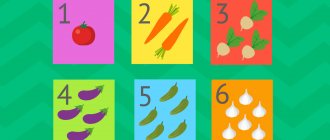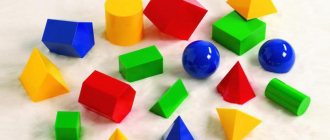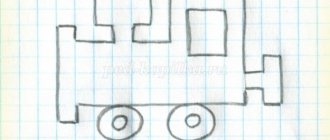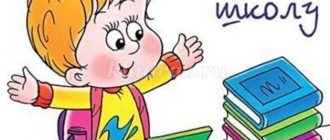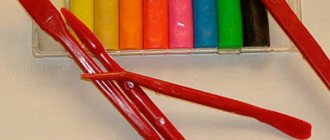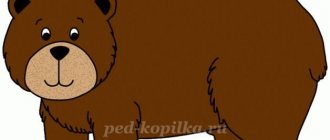Program content
Learn to form the number 3 from two smaller numbers and decompose it into two smaller numbers.
Continue familiarizing yourself with numbers from 1 to 9.
Clarify your understanding of a polygon, develop the ability to find its sides, angles and vertices.
Strengthen ideas about the seasons and months of autumn.
Didactic visual material
Demonstration material.
2 sets of cards with numbers from 0 to 9 (two colors), 3 yellow and 3 dark yellow circles, pictures of a fox and a cat, a square made of counting sticks, a picture of a fox made of polygons, a model “Seasons” "
Handout.
Counting sticks (4 pieces for each child), 3 yellow and 3 red circles (for each child), plasticine, envelopes with geometric shapes.
Guidelines
Part I. Game exercise “Make a number”.
The teacher reminds the children of the plot of A. Tolstoy’s fairy tale “The Golden Key”. Then he lays out 3 yellow circles on the flannelgraph and says that these are 3 gold coins belonging to the cat Basilio and the fox Alice. The teacher clarifies: “How many coins are there in total? How many coins of what color? How did you come up with the number three? (One, one and one more.)
The teacher tells the children that Alice the fox and Basilio the cat are trying to divide the coins between themselves. The teacher replaces the last circle with a dark yellow circle and asks: “How many coins does Alice have? How many coins of what color? How did Alice get three coins? ( Two and one coin.)
Children place the corresponding numbers under the coins.
“Basilio the cat suggests dividing the coins differently: one yellow coin and two dark yellow ones,” continues the teacher. – How many coins does Basilio have? How many coins of what color? How did Basilio get three coins?” (One yellow and two dark yellow.)
Children put out numbers 1 and 2.
The teacher continues: “Alice the Fox claims that two and one will be three and one and two will also be three. Is Alice right? (Children express their guesses.)
Part II. Game exercise “Let's help the cat Basilio and the fox Alice divide three coins.”
The teacher gives the children the task: “Make the number three using yellow and red circles: place circles of one color on the left and the other on the right.”
After completing the task, the teacher asks the children how they made up the number 3 (2 and 1, 1 and 2).
Then the teacher invites the children to divide 3 coins equally between the cat Basilio and the fox Alice. The teacher listens to the children's answers and concludes: “You cannot divide three coins equally, since the number three consists of the numbers two and one or one and two.”
Part III. Outdoor game “Whose team will assemble faster?”
Children are divided into two units of 10 people each. Each child takes one card with a number from 0 to 9. (Each section of the card has its own color.) The rest of the children are the judging team.
Children perform various movements to music. With the end of the music, the links are built in order (from 0 to 9). The judging team checks the correct formation of the children.
Then the children change roles and cards and the game is repeated 2-3 times.
At the end of the game, the teacher asks each unit to indicate the number of players using a number. The teacher discusses with the children what numbers they used to represent the number 10 and which side of the unit 0 is located on.
Part IV. Didactic game "Tangram".
Children have 4 counting sticks and a piece of plasticine. The teacher invites the children to compare the lengths of the sticks and connect them using plasticine. Then he clarifies: “What figure did you get? (Square.)
What does a square have?
(Sides and angles.)
How many sides does a square have? How many angles?
The teacher shows the same model of a square and explains (at the same time showing) that the point where the sides of the square connect is called the vertex. The teacher asks the children to show and count the vertices of the squares.
“What else can you call a square? – the teacher clarifies. “That’s right, a polygon (quadrangle).”
The teacher invites the children to take out the figures for the game “Tangram” from the envelopes and asks: “What are the names of the figures? How else can they be called in one word? What do these figures have? (Sides, corners, vertices.)
Now let's assemble the fox Alice from geometric shapes. (Shows a sample.) What polygons did you use to make the fox?”
Part V Game exercise “Seasons”.
The teacher shows the children the “Seasons” model: a square divided into 4 parts (seasons), colored red, green, blue and yellow. The yellow part is divided into 3 more parts, colored in light yellow, yellow and yellow-brown.
The teacher asks the children: “How many seasons are there in total? Name them in order. (Shows the seasons on the model, specifying the color and their names.)
Show autumn on the model. How many parts is this season divided into? Why do you think there are three parts? What months of autumn do you know? The last month of autumn is November. Name the months of autumn in order." (September October November.)
The teacher shows the months on the model.
